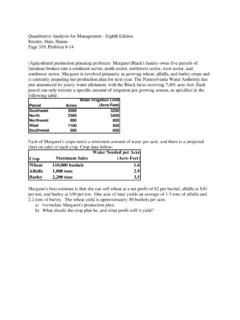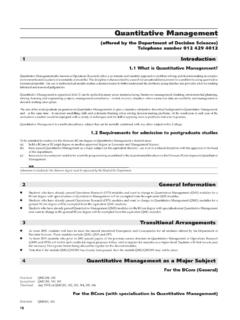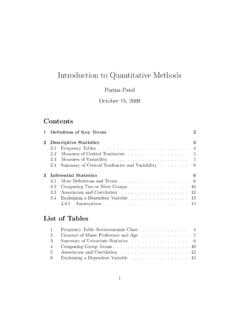Transcription of Introduction to Traditionally business decisions have been ...
1 Chapter 1 Introduction to quantitative analysis 2008 Prentice-Hall, analysis for Management, Tenth Edition,by Render, Stair, and HannaIntroduction Traditionally business decisions have been based on subjective factors Though mathematical tools have been used for thousands of years, the formal study of it to make management decisions 1 2study of it to make management decisions began in twentieth century quantitative analysis is based on numeric data analysis , modeling and mathematical calculations quantitative analysis can be used to solve a wide variety of problems in business , government, health care, education, .. Introduction It s not enough to just know how the mathematics of a technique (model) works One must understand the specific applicability of the technique (model), its limitations, and its assumptions1 3limitations, and its assumptions The terms management science, operations management or research, and quantitative analysis are often interchangeableWhat is Operations Management ?
2 A set of activities that creates value in the form of goods and services by carefully managing the business operations to produce and distribute products and services efficiently and effectively1 4services efficiently and effectively Increase profit .. Reduce cost .. One of three major functions (marketing, finance, and operations) of any organization and is integrally related to all the other business functions What is Operations Management ? Operations Management (OM) is such a costly part of an organization A large percentage of the revenue of most firms is spent in the OM function1 5most firms is spent in the OM function OM provides a major opportunity for an organization to improve its profitability and enhance its service to societyWhat is Operations Management ? Operations management involves using quantitative analysis methods to help people analyze complicated business processes and make good 1 6business processes and make good decisions These techniques are especially useful for helping understand and deal with business complexity and uncertaintyExamples of quantitative Analyses Taco Bell saved over $150 million using demand forecasting and employee scheduling quantitative analysis models NBC television increased revenues by over 1 7 NBC television increased revenues by over $200 million by using quantitative analysis to develop better sales plans for advertisers Continental Airlines saved over $40 million using quantitative analysis models to quickly recover from weather delays and other disruptionsQuantitative analysis (QA) quantitative analysis (QA)is a scientific approach to managerial decision making no whim, emotions and guesswork.
3 The heart of QA is the processing and manipulating of raw data into meaningful informationWhat is quantitative analysis ?1 8data into meaningful informationMeaningfulInformationQuantita tiveAnalysisRaw DataQualitative analysisQualitative analysisinvolves the investigation of factors in a decision-making problem that cannot be quantifiedIn solving real problems, both quantitative and qualitative factors must be consideredQuantitative factorsQuantitative factorsmight be different investment alternatives, interest rates, inventory levels, demand, or labor costWhat is quantitative analysis ?1 9inventory levels, demand, or labor costQualitative factorsQualitative factorssuch as the weather condition, state and federal legislation, the outcome of an election, technology breakthroughs, etc. may be difficult to quantify but can affect the decision-making process In most cases quantitative analysis will be an aid to the decision-making process.
4 The results of quantitative analysis What is quantitative analysis ?1 10 The results of quantitative analysis will be combined with other (qualitative) information in making the final Input DataDeveloping a ModelThe quantitative analysis ApproachDefining the Problem1 11 Implementing the ResultsAnalyzing the ResultsTesting the SolutionDeveloping a SolutionAcquiring Input DataFigure Defining the ProblemThe first step is to develop a clear and concise statement of the problem that gives direction and meaning to the subsequent steps This may be the most important and difficult step It is essential to go beyond the symptoms of the 1 12 It is essential to go beyond the symptoms of the problem and identify true causes Several problems may exist. It is necessary to concentrate on only a few of the problems selecting the right problems is very important If the problem is difficult to quantify, specific and measurable objectives may have to be developed ( inadequate hospital health care delivery raise # of beds, doctors, reduce waiting time.)
5 2. Developing a ModelQuantitative analysis models are realistic, solvable, and understandable mathematical representations of a situation$ SalesMathematic 1 13 There are other types of models$ Advertising$ SalesSchematic modelsScale modelsMathematic models2. Developing a Model QA Models generally contain variables(controllable and uncontrollable) and parameters Variables are measurable quantities that 1 14 Variables are measurable quantities that are subject to change and are generally unknown ( $ sales, $ advertising) Controllable variables are generally the decision variables ( $ advertising) Parameters are known quantities that are a part of the problem ( cost per second rate for the ads)3. Acquiring Input DataInput data must be obtained for the model to make it useful and they must be accurate GIGO ruleGarbage In1 15 Data may come from a variety of sources such as company reports, company documents, interviews, on-site direct measurement, or statistical samplingInProcessGarbage Out4.
6 Developing a Solution The best (optimal) solution to a problem is found by manipulating the model until a solution is found that is practical and can be implemented Common techniques are1 16 Common techniques are SolvingSolvingequations Trial and errorTrial and error trying various approaches and picking the best result Complete enumerationComplete enumeration trying all possible values Using an algorithmalgorithm a series of repeating steps to reach a solution The input data and model determine the accuracy of the solution5. Testing the SolutionBoth input data and the model should be tested for accuracy before the solution can be analyzed and implementedCollect additional data from a different 1 17 Collect additional data from a different source to validate the accuracy of both the model and model input data Results should be logical, consistent, and represent the real situation6. Analyzing the ResultsDetermine the implications of the solution Implementing results often requires actions and changes in an organization The impact of actions or changes needs to be studied and understood before 1 18be studied and understood before implementationSensitivity analysisSensitivity analysisdetermines how much the results of the analysis will change if the model or input data changes A model is only an approximation of reality Sensitive models should be very thoroughly tested to ensure their accuracy and validity7.
7 Implementing the ResultsImplementation incorporates the solution into the company Implementation can be very difficult People can resist changes Many quantitative analysis efforts have failed 1 19 Many quantitative analysis efforts have failed because a good, workable solution was not properly implementedChanges occur over time, so even successful implementations must be monitored to determine if modifications are necessaryModeling in the Real WorldQuantitative analysis models are used extensively by real organizations to solve real problems In the real world, quantitative analysis models can be complex, expensive, and 1 20models can be complex, expensive, and difficult to sell Following the steps of quantitative analysis is an important component of success, but not a guaranteeHow To Develop a quantitative analysis Model Developing a model is an important part of the quantitative analysis approach Let s look at a simple mathematical model of profit1 21model of profitProfit = Revenue Expenses How To Develop a quantitative analysis ModelExpenses can be represented as the sum of fixed and variable costs and variable costs are the product of unit costs times the number of unitsProfit = Revenue (Fixed cost + Variable cost)Profit =(Selling price per unit)(number of units 1 22 Profit =(Selling price per unit)(number of units sold) [Fixed cost + (Variable costs per unit)(Number of units sold))]
8 ]Profit =sX [f+vX]Profit =sX f vXwheres= selling price per unitv= variable cost per unitf= fixed costX= number of units soldHow To Develop a quantitative analysis ModelExpenses can be represented as the sum of fixed and variable costs and variable costs are the product of unit costs times the number of unitsProfit = Revenue (Fixed cost + Variable cost)Profit =(Selling price per unit)(number of units The parametersof this model are f, v, and sas these are the inputs inherent in the modelProfit and Xare variablesThe decision variableof 1 23 Profit =(Selling price per unit)(number of units sold) [Fixed cost + (Variable costs per unit)(Number of units sold)]Profit =sX [f+vX]Profit =sX f vXwheres= selling price per unitv= variable cost per unitf= fixed costX= number of units soldThe decision variableof interest is XPritchett s Precious Time PiecesThe company buys, sells, and repairs old clocks and clock parts. Rebuilt springs sell for $10 per unit.)
9 Fixed cost of equipment to build springs is $1,000. Variable cost for spring material is $5 per 10f= 1,000v= 51 24 Profits = sX f vX = 10X 1000 5Xs= 10f= 1,000v= 5 Number of spring sets sold = XIf sales = 0, profits = $1,000$1,000If sales = 1,000, profits = [(10)(1,000) 1,000 (5)(1,000)]= $4,000 Pritchett s Precious Time Pieces0 = sX f vX, or 0 = (s v)X fCompanies are often interested in their breakbreak--even even pointpoint(BEP). The BEP is the number of units sold that will result in $0 25 Solving for X, we havef = (s v)XX= fs vBEP = Fixed cost(Selling price per unit) (Variable cost per unit)Pritchett s Precious Time Pieces0 = sX f vX, or 0 = (s v)X fCompanies are often interested in their breakbreak--even even pointpoint(BEP). The BEP is the number of units sold that will result in $0 for Pritchett s Precious Time PiecesBEP = $1,000/($10 $5) = 200 unitsSales of less than 200 units of rebuilt springs 1 26 Solving for X, we havef = (s v)XX= fs vBEP = Fixed cost(Selling price per unit) (Variable cost per unit)Sales of less than 200 units of rebuilt springs will result in a lossSales of over 200 units of rebuilt springs will result in a profitBagels R UsAssume you are the new owner of Bagels R Us and you want to develop a mathematical model for your daily profits and breakeven point.
10 Your fixed overhead is $100 per day and your variable costs are per bagel (these are GREAT bagels). You charge $1 per 27 Profits=$1*Number Sold $100 $.50*Number Sold(Price per Unit) (Number Sold) Fixed Cost (Variable Cost/Unit) (Number Sold)Profits = Revenue ExpensesBagels R Usf = $100, s= $1, v= $.50 BEP = f/ (s v)1 28 BEP = $100 / ($1 $.50)BEP = 200 unitsWhen the number of units sold is equal to 200, the profit is of Mathematical can accurately represent can help a decision maker formulate can give us insight and information1 can give us insight and can save time and money in decision making and problem model may be the only way to solve large or complex problems in a timely model can be used to communicate problems and solutions to othersModels Categorized by Risk Mathematical models that do not involve risk are called deterministicmodels We know all the values used in the model with complete certainty (the outcome is also certain)1 30 profit and break-even models Mathematical models that involve risk, chance, or uncertainty are called probabilisticmodels Values used in the model are estimates based on probabilities (the outcome is not certain) market for a new product.














